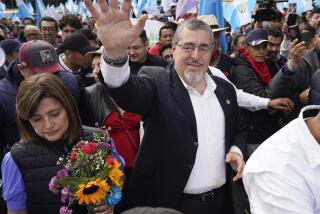Documents Reveal CIA Guatemala Assassination Plots
- Share via
WASHINGTON — The CIA considered assassinating dozens of Guatemalan political leaders as part of a 1954 covert action that toppled the government, according to newly declassified documents.
The CIA-engineered coup in Guatemala, motivated by a mixture of U.S. economic interests and Cold War paranoia, has long been recognized by historians as a dark episode in U.S. foreign policy during the post-World War II era.
But the CIA’s proposals for dozens of political killings in Guatemala had never been publicly known until now.
On Friday, 1,400 pages of CIA documents on the coup--a fraction of the total still classified by the CIA--were declassified and put on public display at the National Archives in suburban Maryland. Those documents reveal the lengths to which U.S. officials were willing to go in order to ensure that the Central American country remained in the U.S. sphere of influence.
The CIA now stresses that it does not believe that any Guatemalan officials were actually assassinated on CIA orders during the coup.
The CIA’s history of the coup adds that the assassination proposals were never formally approved by policymakers in Washington.
But the documents show that the CIA weighed whether to execute supposed Communists and “those in high positions of the government” whose elimination would “bring about its collapse.”
CIA and State Department officials also reviewed hit lists proposed by U.S.-backed Guatemalan “rebels” who wanted to kill as many as 58 political enemies as soon as they seized power.
The documents also show how the CIA planned to cover its tracks by instigating false provocations for a rebellion, including desecrating churches and cemeteries with pro-Communist graffiti.
According to an internal CIA history of the covert action, made public along with the newly declassified documents, the CIA’s plans included drawing up “lists of individuals for assassination”, “training Guatemalan exiles for assassination teams” and conducting “intimidation programs against prominent Guatemalan officials.”
The documents provide a startling glimpse into an era when the CIA--free from congressional oversight and public scrutiny--was generally able to do as it pleased in developing nations.
Plotting for the overthrow of the Guatemalan government of President Jacobo Arbenz began in 1952 during the Truman administration, when the U.S. began to worry that Arbenz was not only coming under Communist influence but that his agrarian reform efforts threatened U.S. business interests--especially the huge land holdings of the United Fruit Co.
In April 1952, Nicaraguan President Anastasio Somoza Debayle visited Washington and boasted to President Truman that he and Guatemalan exile Carolos Castillo Armas could overthrow Arbenz if they were provided arms and support by the United States. Truman asked then-CIA Director Walter Bedell Smith to investigate the possibility, starting a chain of secret actions that ultimately led to Arbenz’s overthrow.
Just before the coup was launched, the CIA proposed a series of staged provocations that would give anti-Arbenz rebels cover for their actions. Among other acts, CIA officers proposed setting fire to a United Fruit Co. property or the house of a wealthy Guatemalan landowner and making it look like the work of Communists.
“After a few days of the [destabilizing activity has] created a sufficiently strong impression of beginning Communist terror, countermeasures would set in, beginning with blowing up offices, attacking homes of Communist officials, using personal nerve war techniques to the utmost,” one CIA document said.
The U.S.-backed rebels finally struck in June 1954. Arbenz resigned on June 27, and Castillo Armas seized power.
Before the coup, a CIA officer reported that Washington believed that “Arbenz must go; how does not matter.”
More to Read
Sign up for Essential California
The most important California stories and recommendations in your inbox every morning.
You may occasionally receive promotional content from the Los Angeles Times.










